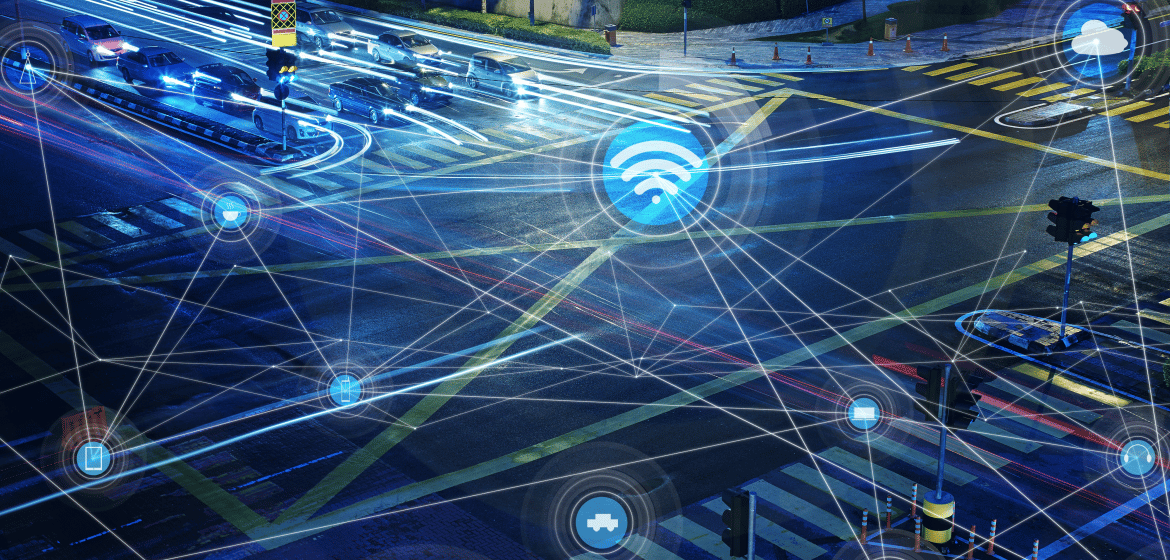
5GAA recommends the FHWA to rely on C-V2X to advance towards the next generation of North America’s transportation network
As Automatic Driving Systems (ADS) are increasingly being tested and introduced onto public roadways, the Federal Highway Administration (FHWA) made public its interest on hearing from transport-related stakeholders on some of the issues concerning infrastructure requirements and standards that may be necessary to enable safe and efficient ADS operations through a public Request for Information (RFI).
With the objective to contribute to this FHWA request, 5GAA has submitted a series of comments in response to the RFI which try and explain the features and benefits of Cellular-Vehicle-to-Everything technology (C-V2X). Being complementary to ADS technology, C-V2X holds tremendous potential to improve road safety by facilitating the flow of information between vehicles, pedestrians, cyclists, road infrastructure and commercial cellular mobile networks. 5GAA also believes that deployment of C-V2X technology will potentially save taxpayer money which otherwise would be used to deploy, maintain and upgrade roadside units (RSU) utilized by non-cellular technologies.
Moreover, for other benefits such as having the advantage of a higher spectrum efficiency, the capacity to support larger ranges or the fact that the use of C-V2X can make use of already available and deployed cellular networks, 5GAA urges the FHWA to consider further how it can leverage the benefits of C-V2X and synergies between commercial mobile networks and the development of connected transportation safety services.
Read the full publication here.
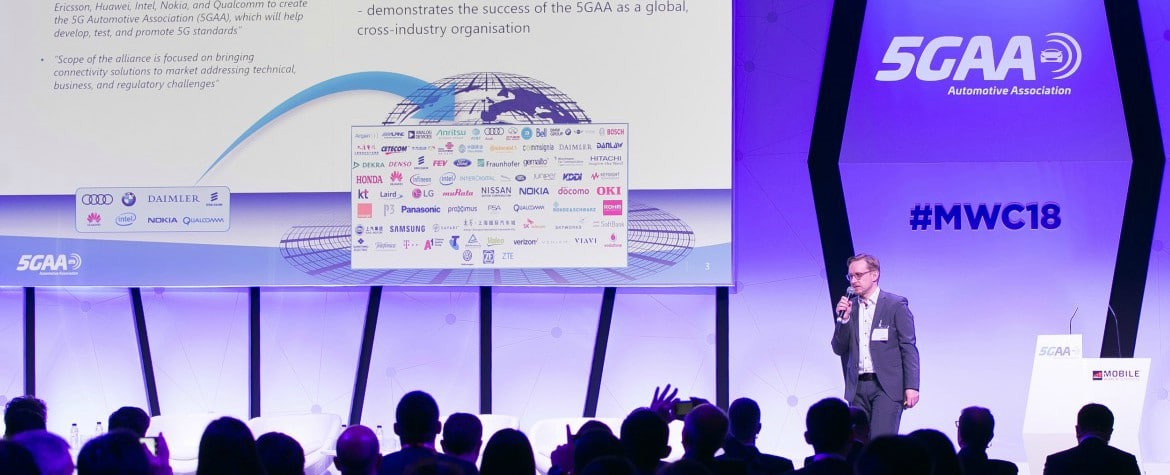
MWC 2018: 5GAA Gaining Speed Toward C-V2X commercialization
March 2nd, Barcelona, Spain – The 5G Automotive Association (5GAA) presented – during a session at the Mobile World Congress 2018 – the acceleration of C-V2X technology implementation through the widespread support of leading telecommunications and automotive companies. This advanced technology will serve as the lynchpin that will create a connected vehicle ecosystem and enable future mobility solutions. March 1st, Barcelona, Spain – The 5G Automotive Association (5GAA) presented – during a session at the Mobile World Congress 2018 – the acceleration of C-V2X technology implementation through the widespread support of leading telecommunications and automotive companies. This advanced technology will serve as the lynchpin that will create a connected vehicle ecosystem and enable future mobility solutions.
The value of C-V2X technology lies in the fact that it is a unified technology – it can provide short-range and long-range communications. C-V2X technology can, for example, alert drivers of a cyclist around the corner or a traffic jam that is 25 kilometers away.
Christoph Voigt, 5GAA Chairman and Head of R&D Connectivity at Audi announced that: “This effort is now ‘all hands on deck’, meaning that telecommunications and automotive leaders are all working hand-in-hand to deploy C-V2X and to make it hit the road as soon as possible.”
During its session, 5GAA focused on the growing support that C-V2X technology is enjoying among leading companies in the telecommunications and automotive industries and presented the importance that 5G cellular technology will play in enabling smart mobility of the future.
C-V2X gains wide ecosystem support
During the presentation, 5GAA members Qualcomm and Huawei emphasized the growing C-V2X ecosystem support and presented their integrated chipsets that will enable C-V2X commercialization. The start of C-V2X mass market series deployment is predicted to begin as early as 2019/2020.
“We see a growing appetite across the industry for the commercialization of our C-V2X chipset with automakers, Tier-1 suppliers, cellular module manufacturers, ITS providers, integrators, and automakers ready to drive change,” said Jason Ellis, Director of Automotive Business Development at Qualcomm.
Veni Shone, President of LTE product line at Huawei, highlighted that the momentum of C-V2X in China is encouraging – ministries have put their full support behind C-V2X technology on strategy and standardization. Mr. Shone also detailed Huawei’s commitment to accelerate C-V2X, specifically pointing at the releases of its LTE-V2X chipset, T-box prototype, and roadside units.
5GAA plans to support and advocate the work of this technology by speeding up the deployment of C-V2X for the automotive sector while creating a joint ecosystem and implementing key functionalities such as vehicle-to-smart-device.
5G as an enabler for life-saving solutions & new business applications
5GAA members Ericsson and Ford also highlighted exciting use cases and growing business applications for 5G technology in the automotive sector.
Don Butler, Executive Director of Connected Vehicles and Services at Ford stated that: “Creating safer and more personalized journeys through automated driving is the long-term vision of mobility’s future. We believe 5G will enable this by maximizing the in-vehicle experience thanks to high reliability, fast-paced communications. We will create new, compelling experiences and capabilities saving more lives with patient transport monitoring or teleoperated driving.”
With the advancement of 5G technology and its application to connected vehicles, the amount of data created will continue to expand exponentially.
Stefano Sorrentino, Master Researcher at Ericsson presented the fact that: “Connected & automated driving will lead to a data explosion that will definitely challenge the network capacities. This challenge could be remedied through the deployment of scalable and integrated networks and cloud architectures as well as the continuous evolution of radio technology into 5G.”
“We think of 5G as an end-to-end solution starting with the wireless connectivity but also including edge computing, the transport network, artificial intelligence and machine learning. Together they power the applications and the services for intelligent transportation and smart mobility, and ultimately, the ways humans interact with connected and self-driving cars of the future. It is an exciting area for 5GAA to work on and we invite any stakeholder to join us and contribute on this journey.” concluded Thierry Klein, Head of Disruptive Innovation Program at Nokia Bell Labs and Vice Chair of 5GAA Board.
About 5GAA
The 5G Automotive Association (5GAA) is a global cross-industry organization of companies from the automotive, technology and telecommunications industries (ICT), working together to develop end-to-end solutions for future mobility and transportation services. Created in 2016, the Association is comprised of over 75 members whose mission is to develop, test and promote communications solutions, initiate their standardisation and accelerate their commercial availability and global market penetration, to address society’s connected mobility and road safety needs with applications such as automated driving, ubiquitous access to services and integration into smart city and intelligent transportation.

5GAA presents the Future of Connected Mobility at Mobile World Congress Barcelona – 27th February
5G Automotive Association (5GAA), is looking forward to hosting an engaging event at this year’s Mobile World Congress (MWC) in Barcelona. The event will take place from 9 am until 1 pm on Tuesday, 27th February in Hall 8.0 NEXTech Theatre B. The event will be one of the only opportunities at MWC to hear about 5G mobility, the roadmap to connected vehicles, and C-V2X technology’s growing ecosystem of supporters.
Every year at the Mobile World Congress, the mobile ecosystem and related industries such as the automotive one meet to discuss and reveal the latest innovation and technology advances within the field. This year, 5GAA takes a centre role in the congress programme.
Tuesday’s event will consist of two sessions, each composed of two presentations and a panel discussion. Speakers from AUDI AG, BMW Group, Qualcomm, Harman, Ericsson, Huawei, Intel, Nokia, and more will debate on the revolution the C-V2X technology and its evolutionary path towards 5G will bring to our future mobility ecosystem. The session will be followed by a networking lunch from 12 – 1pm.
About the 5GAA
The 5GAA is a cross-industry association between the cellular and automotive industries to develop, test and promote communications solutions, initiate their standardisation and accelerate their commercial availability and global market penetration, to address society’s connected mobility and road safety needs with applications such as automated driving, ubiquitous access to services and integration into smart city and intelligent transportation.

5GAA Announces Deployment of LTE-V2X by 2020
The C-V2X technology tested, validated, and commercially available in vehicles in 2020
The inclusion of cellular communication technologies (V2N – Vehicle2Network) into vehicles (i.e. “Connected Cars”) has been extremely successful, and since early deployments in the last couple of decades, we continue to see an expansion of how these technologies can deliver benefits for the vehicle, the driver, and other participants in the transportation ecosystem.
At present, the automotive manufacturing members of 5GAA operate more than 20 million Connected Cars that have the ability to connect to cellular networks (V2N). This V2N connection is used for a wide variety of application domains including telematics, infotainment, traffic optimization, as well as for safety applications like the recognition of slow or stationary vehicle(s) and warnings for such events as traffic jam ahead, road works and other traffic infrastructure related information, inclement weather conditions, emergency brake light and other hazard warnings. The current understanding, also based on the European C-ITS Platform Final Report, is that the nature of these warning messages is informational and the driver is responsible at all times.
As defined in the approved 3GPP Release 14 in June 2017, cellular networks are able to take another evolutionary step in the pathway to broaden the reach and applicability of benefits. ![]() In particular, this release addresses the challenges of delivering increased data volume, managing greater scale in connected devices, significantly reduced latency and providing higher levels of reliability. These defined attributes and an advanced architecture provide unprecedented support for the support of safety-critical communications, referred to as Cellular Vehicle to Everything (Cellular-V2X or C-V2X). In addition to such V2N enhancements, which rely on existing cellular networks, 3GPP Release-14 introduces the ability to support short-range communications between vehicles (V2V) and vehicle and road side infrastructure (V2I and I2V) without requiring any cellular network coverage.
In particular, this release addresses the challenges of delivering increased data volume, managing greater scale in connected devices, significantly reduced latency and providing higher levels of reliability. These defined attributes and an advanced architecture provide unprecedented support for the support of safety-critical communications, referred to as Cellular Vehicle to Everything (Cellular-V2X or C-V2X). In addition to such V2N enhancements, which rely on existing cellular networks, 3GPP Release-14 introduces the ability to support short-range communications between vehicles (V2V) and vehicle and road side infrastructure (V2I and I2V) without requiring any cellular network coverage.
3GPP Release 14 including C-V2X is also a key step to the next generation of cellular technology, 5G. Naturally C-V2X is already on a backwards compatible evolution path with enhancements being specified beginning with 3GPP Release 15.
The members of 5GAA are wholly committed to collaborating to ensure that the potential of the C-V2X technology is realized. This includes leading efforts to address key technical and regulatory issues, as well as integrating vehicle platforms with advanced cellular connectivity, networking and computing solutions.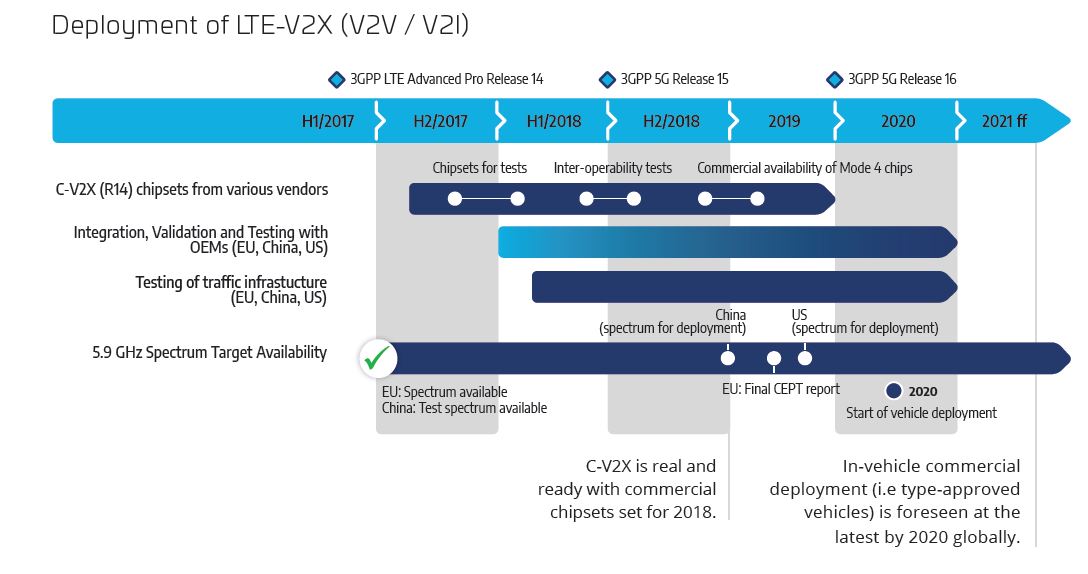
It is with this cooperation, collaboration, and commitment that 5GAA members continue to work to ensure that C-V2X technology is tested, validated, and commercially available in vehicles in 2020.
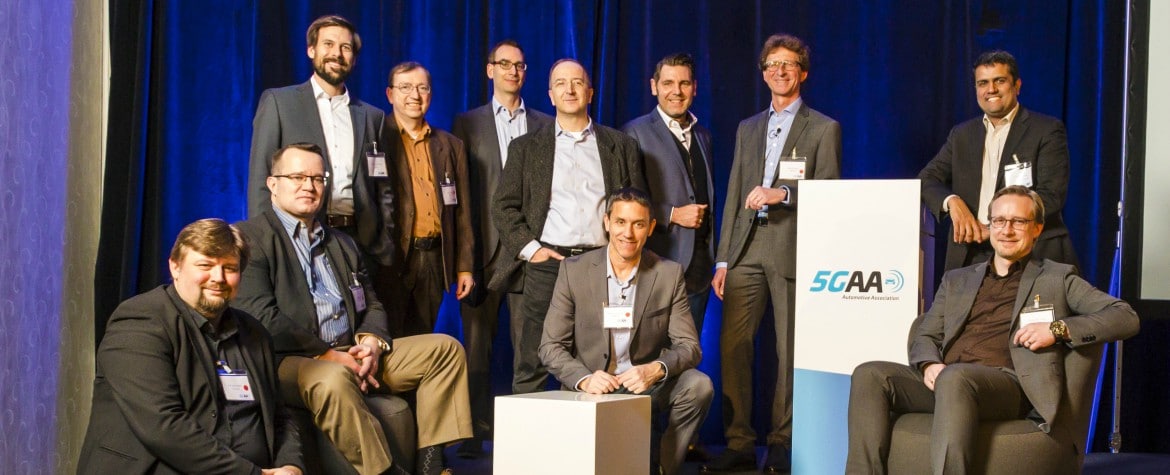
C-V2X & Edge Computing: The Winning Technologies for Connected Vehicles and Autonomous Driving
Munich, Germany – On 8th February 2018, the 5G Automotive Association lead a successful Open Workshop on “Edge Computing and V2X“. The workshop – open to both 5GAA members and non-members – aimed to provide a discussion platform for the wide range of stakeholder advocating for the evolution of cloud computing in the automotive sector.
Edge Computing offers cloud computing capabilities at the edge of the network. Several demonstrated C-V2X use case trials have already proven the potential of Edge Computing to serve real C-V2X scenarios. 5GAA considers Edge Computing as one of the key supporting technologies for many of the foreseen V2X services for connected vehicles and for Autonomous Driving.
The Munich workshop brought together industry stakeholders from car OEMs, OEM suppliers, road and mobile network operators to edge computing technology vendors. Edge Computing was covered from various perspectives, illustrating its potential to further expand the competitiveness of C-V2X as the technology of choice for C-ITS. The unique position of 5GAA in the technology and solutions development was again highlighted.
The automotive sector, including OEM suppliers and car makers, shared their thinking and experiences with the technology. The event culminated in the panel discussion which included consideration of use cases and requirements and on how to best utilise the networks and Edge Computing for C-V2X.
Finally, the participating companies concluded a common understanding on the way forward:
- Edge Computing has a great value proposition for C-V2X and its evolution, as it further increases the competitiveness of C-V2X and its infrastructure component (LTE-Uu) over the alternative ITS-G5 technology.
- Technical discussions are to continue in the 5GAA working groups; further collaboration with standardization bodies is encouraged to continue and expand.
- Future workshops similar to this one can be considered, e.g. again collocated with a future 5GAA meeting.
About the 5GAA
The 5GAA is a cross-industry association between the cellular and automotive industries to develop, test and promote communications solutions, initiate their standardisation and accelerate their commercial availability and global market penetration, to address society’s connected mobility and road safety needs with applications such as automated driving, ubiquitous access to services and integration into smart city and intelligent transportation.

Toward fully connected vehicles: Edge computing for advanced automotive communications
Connected Vehicles and especially connected Autonomous Driving (AD) vehicles bring a whole new ecosystem with new requirements on the Cloud and the network architecture to support the new workloads and to satisfy the real-time service requirements. Such ecosystem includes the vehicles, the road infrastructure, the network infrastructure, and the Cloud.
Edge Computing based Vehicle-to-Cloud solutions enable edge cloud capabilities for different levels of autonomous driving, including Highly Autonomous Driving (HAD) and Fully Autonomous Driving (FAD) through providing different services for the driving process (e.g., High Definition real-time Maps, real-time traffic monitoring and alerts, and richer passengers experience), supporting vehicles on roads to drive co-operatively and to be aware of road hazards, and providing better user experience and trust to drivers and passengers.
This white paper provides an overview of automotive use cases and shows how Edge Computing provides compute/storage/networking capabilities at the network edge, and how it can be considered a supporting technology for multiple services for connected AD vehicles. The paper draws the attention to the value of Multi-access Edge Computing (MEC) as a standardized solution for Edge Computing, especially important from automotive stakeholders’ point of view (while also serving other vertical market segments). In particular, from a standardization perspective, some use cases targeting fully connected cars (i.e. FAD with the maximum level of automation) have challenging requirements that may be fulfilled only with the introduction of 5G networks. Finally, this paper also illustrates the opportunities that are here already today in deploying Edge Computing to support AD, using the flagship services as examples.
Read the full paper here.
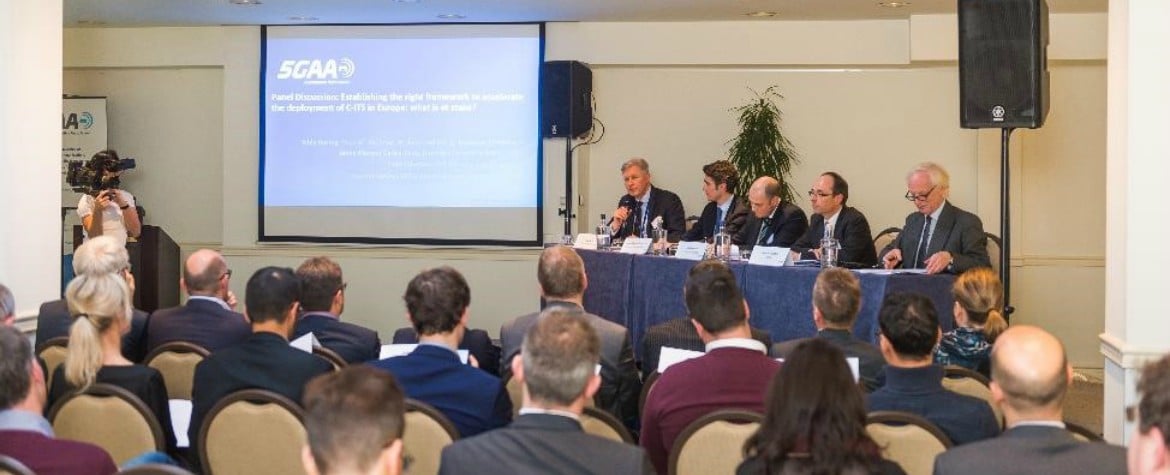
Peaceful coexistence of C-V2X and ITS-G5 technology offers the highest net benefits for Europe
5GAA and EU policymakers discuss future of 5G for connected and automated vehicles
12 December 2017, Brussels, Belgium – The 5G Automotive Association (5GAA), a cross-industry association of the telecoms and automotive industry, held a policy debate on Tuesday 5 December in Brussels to discuss the concrete actions necessary to implement 5G connected and automated vehicles in Europe. A recurring theme in Tuesday’s debate was the cohesive development and implementation of cellular “vehicle to everything” (C-V2X) technology, the technology that will enable automobiles to communicate via cellular networks to other connected devices but also the possibility of ad-hoc communication without any cellular network involvement (e.g. in case of weak coverage). Policymakers and industry face the ongoing challenge of creating a cohesive framework that enables private sector innovation while ensuring a safe and economically viable rollout of new technologies.
Attendees heard from a wide range from various European political and administrative representatives, including Eddy Hartog, EC Head of Unit Smart Mobility and Living, Attila Benedek (Adviser to István Ujhelyi MEP, rapporteur on European C-ITS Strategy), Jaime Moreno García-Cano of the Spanish traffic authority or Andreas Geiss, EC Head of Unit for Spectrum Policy. 5GAA was represented by its Secretary, Markus Dillinger of Huawei and board members, Luke Ibbetson of Vodafone, Joachim Göthel of BMW, Rainer Krumrein of Daimler, and Friedhelm Ramme of Ericsson.
The debate coincides with the Commission’s ongoing public consultation on its European Strategy on Cooperative Intelligent Transport Systems (C-ITS), which runs through January 5, 2018. C-V2X technology stands to significantly improve road safety and facilitate traffic flows in the EU. Ultimately, the benefits of this technology across the EU could save the several billion euros that are lost every year to traffic accidents and congested roadways.
Markus Dillinger, 5GAA Secretary and Member of the Executive Committee: “5GAA was founded to underscore the urgency in developing technology that makes our roads safer and smarter. Today’s debate brought together public and private sector stakeholders to discuss the capabilities of such technology as well as the acceleration of creating a regulatory framework in which the industry can work.”
During the event, analysts from Analysys Mason and SBD Automotive presented the findings of a cost-benefit analysis of implementing the C-V2X technology. The socio-economic returns of deployment of C-ITS systems may amount to EUR 43 billion by 2035 in Europe, if both C-V2X and the Wi-Fi Standard IEEE 802.11p are able to co-exist in the 5.9GHz spectrum band. The 5GAA also presented a study assessing the road safety benefits of LTE–V2X (PC-5) and IEEE 802.11p in the EU, which indicates that LTE-V2X (PC5) outperforms 802.11p in reducing fatalities and serious injuries. In addition, it demonstrates that the absence of interoperability between technologies is unlikely to present a substantive barrier to the reduction of road accidents in the short to medium term. Bill McKinley, 5GAA rapporteur on tests and trials, and Rainer Krumrein of Daimler also presented 5GAA’s perspective on C-V2X performance and future capabilities.
The event culminated in a panel discussion to discuss the right framework to accelerate the deployment of the C-ITS across Europe. Particular attention was given to short-range communications in the 5.9 GHz band and the four guiding policy principles established by the European Commission: uncompromised safety services for all users in case of multiple technologies implementation, technology neutrality of spectrum regulation, efficient spectrum use and introduction in the longer-term of 5G for the further development of cooperative, connected and automated mobility.
Luke Ibbetson, R&D Director Vodafone Group and member of 5GAA: “Both C-V2X and ITS-G5 technologies should peacefully co-exist in the 5.9 GHz band. The socio-economic and road safety studies presented at this event indicate that co-existence offers the highest net benefits for the European economy, amounting to EUR 43 billion by 2035.”
Joachim Göthel, Senior Manager Project 5G-Alliance of BMW and member of 5GAA: “C-V2X offers a strong evolution path to 5G which is absolutely essential to enable full connected and automated driving in the future, while enabling a fast roll-out for many functionalities in the very short-term, utilizing existing cellular networks.”
The presentations made during the Workshop are downloadable here below:
1. Introductory 5GAA Presentation
2. Presentation on cellular V2X socio-economic benefit study
3. LTE-V2X (PC5) and road safety in the EU
4. 5GAA Presentation Trials
5. Daimler view on V2X – 5GAA Policy Debate
About the 5GAA
The 5GAA is a cross-industry association between the cellular and automotive industries to develop, test and promote communications solutions, initiate their standardisation and accelerate their commercial availability and global market penetration, to address society’s connected mobility and road safety needs with applications such as automated driving, ubiquitous access to services and integration into smart city and intelligent transportation.
Pictures credit © Thomas Blairon, 2017. Reproduction of this image is authorised, provided the source is acknowledged

5GAA Study | The cost-benefit analysis on cellular vehicle-to-everything (C-V2X) technology and its evolution to 5G-V2X
This report, authored by independent telecoms, media and technology consultants Analysys Mason together with automotive consultancy SBD Automotive, assesses the benefits of cellular vehicle to everything (C‑V2X) technology for delivery of vehicle-to-everything (V2X) communication. The report, which has a focus on the benefits of such solutions in Europe, uses qualitative evidence, and describes quantitative cost–benefit analysis that the consultants have undertaken, relating to deployment of C‑V2X.
The purpose of the study has been to examine qualitative evidence and perform quantitative analysis, regarding the net benefits of C‑V2X. Quantitative analysis is focused on the European market, where the European Commission (EC) is currently undertaking a public consultation on the deployment of cooperative intelligent transport systems (C‑ITS).
Read the full study here.
As part of this study, primary research has been conducted to elicit views from the mobile and automotive industries on the benefits of C‑V2X. One-to-one interviews with companies involved in the 5GAA were held, in order to identify several key benefits, as summarised in Figure 1.1 below.
A snippet from the report featuring the benefits of C-V2X [Source: Analysys Mason, 2017]
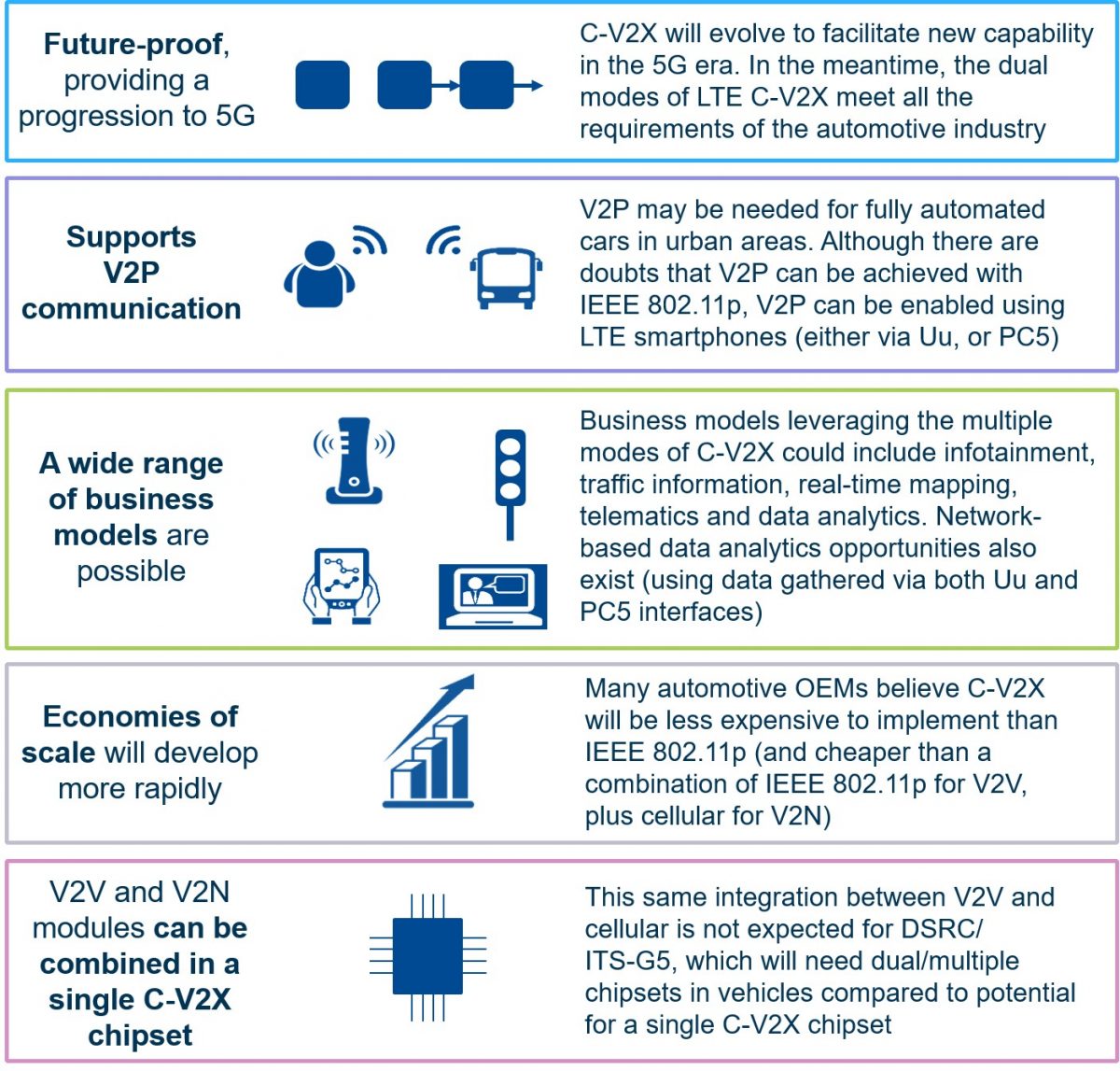

An assessment of LTE-V2X (PC5) and 802.11p direct communications technologies for improved road safety in the EU
This report by the 5G Automotive Alliance (5GAA) presents a quantitative analysis of the ability of Cooperative Intelligent Transport Systems using short-range ad hoc/direct communications to reduce the number of fatalities/serious injuries caused by motoring accidents in the EU. In this context, the study estimates the number of accidents avoided over time through the use of two short-range wireless technologies, 3GPP LTE-V2X (PC5) and IEEE 802.11p, examining their respective performance and projected take-up among road users. The modelling underlying this report has been peer-reviewed and validated by the technology and policy consultancy, Ricardo.
Specifically, two standardised C-ITS short-range technologies are compared for the purposes of this report, namely 3GPP LTE-V2X PC5 (also known as LTE side-link) and IEEE 802.11p (also known as DSRC or ITS-G5), both operating in the 5.9 GHz band for the provision of direct communications between road users. It should be noted that additional reductions in the number of fatalities and serious injuries are possible via longer-range C-ITS communications enabled through interactions with a LTE cellular network, but that these are not considered in this report. Hence, the analysis is limited to LTE-V2X (PC5) only, in comparison to 802.11p.
This study examines and compares two independent counter-factual scenarios: one where LTE-V2X (PC5) is the only deployed C-ITS technology, and the other where 802.11p is the only deployed C-ITS technology.
We consider, as a baseline, the existing and future projected statistics for road traffic fatalities and serious injuries in the EU. We then evaluate the reduction in the number of fatalities and serious injuries which may occur as a result of C-ITS direct communications between road users, by modelling:
- The expected take-up (penetration) of LTE-V2X (PC5) and 802.11p among road users in the EU over time (including vehicles, motorcycles, bicycles and pedestrians), and
- the radio link performance of LTE-V2X (PC5) and 802.11p in successfully delivering actionable warning messages between road users in a number of collision scenarios.
We identify the following conclusions and recommendations from the results of this report:
- The study indicates that LTE-V2X (PC5) outperforms 802.11p in reducing fatalities and serious injuries on the EU’s roads. This is due to a combination of the superior performance of LTE-V2X (PC5) at the radio link level for ad hoc/direct communications between road users, and the market led conditions which better favour the deployment of LTE-V2X in vehicles and in smartphones, and include a clear evolutionary path towards 5G-V2X. For these reasons, it is essential that EU regulations remain technology neutral and do not hinder the deployment of LTE-V2X (PC5) in favour of 802.11p for the provision of direct communications among vehicles and between vehicles and vulnerable road users.
- An absence of interoperability at radio link level between LTE-V2X (PC5) and 802.11p is unlikely to present a substantive barrier to the reduction of road accidents in the EU in the short to medium term. The relatively low penetration of C-ITS technologies in vehicles in the first half of the next decade (and perhaps even later) means that a vehicle equipped with LTE-V2X (PC5) or 802.11p is far more likely to collide with a vehicle that is not equipped with C-ITS technologies at all – indeed it is not until the middle of the next decade that penetration rates are expected to reach a level which results in significant impacts on accident rates. Any regulations which mandate LTE-V2X (PC5) to be backward interoperable with 802.11p will therefore have only a limited effect in the early years of deployment pre-2025. Such regulations may run the risk of unnecessarily distorting the market in favour of 802.11p, thereby obstructing the adoption of LTE-V2X (PC5) and resulting in greater road fatalities and injuries in the longer term.
Read the full study here.

Socio-economic benefits of cellular vehicle-to-everything could amount to 43 Billion Euros by 2035
Brussels, 05th December 2017 – The 5GAA today published a report, authored by independent telecoms, media and technology consultants Analysys Mason together with automotive consultancy SBD Automotive, which assesses the benefits of cellular vehicle to everything (C‑V2X) technology for delivery of vehicle-to-everything (V2X) communication. The report, which has a focus on the benefits of such solutions in Europe, uses qualitative evidence, and describes quantitative cost–benefit analysis that the consultants have undertaken, relating to deployment of C‑V2X.
Publication of the report coincides with policy development on V2X, and use of the 5.9GHz band, in the European Union, where the European Commission is currently undertaking a public consultation on deployment of cooperative intelligent transport systems (C‑ITS).
The study concludes that the deployment of C-ITS systems is beneficial at the European Union level. Net benefits that could be accrued in Europe are estimated to be in the range of EUR20 billion to EUR43 billion in 2035 (with the highest benefits coming from increased road safety, and traffic efficiency), across the four scenarios modelled.
The most favourable scenario of those modelled in the study (amounting to EUR 43 billion net benefits) is where the potential for rapid penetration and economies of scale for C-V2X is maximised and both C-V2X and the Wi-Fi Standard IEEE 802.11p are able to co-exist in the 5.9GHz spectrum band. Such benefits do not arise in a scenario where the use of IEEE 802.11p is mandated for C-ITS services, which would result in less than half these expected net benefits (EUR 20 billion).
The study also indicates benefits of C-V2X for the European market lie in its deployment flexibility, with the ability to provide coverage for both short range and wide area applications, and certainty of future evolution to 5G, potentially facilitating earlier deployment as well as after-market deployment (e.g. V2X services provided in vehicles via a smartphone or other after-market device with C-V2X connectivity).
Reduced infrastructure deployment costs are a further key benefit of C-V2X, from the potential to re-use existing mobile infrastructure, and thus leveraging cellular technology integration and economies of scale, rather than building independently operated roadside infrastructure.
Christoph Voigt, 5GAA Chairman comments: “C-V2X will be fundamental to the deployment of cooperative intelligent transport systems. The benefits highlighted is this report indisputably demonstrate that this technology will lead to major improvements in driving and road safety. It further highlights that the European Commission should take a technology neutral approach and not limit these benefits by mandating the use of the Wi-Fi standard IEEE 802.11p”
The socio-economic benefits study on C-V2X can be found here.
Separately, the 5GAA has also today published a study which carries out a quantitative analysis of LTE–V2X (PC-5) and IEEE 802.11p technologies for short-range ad hoc/direct communications in reducing fatalities and serious injuries caused by motoring accidents in the EU. The modelling underlying this report was peer-reviewed and validated by the technology and policy consultancy, Ricardo. The study find that LTE-V2X (PC5) outperforms 802.11p in reducing fatalities and serious injuries on the EU’s roads. The 5GAA’s study on an assessment of LTE-V2X (PC5) and 802.11p direct communications technologies for improved road safety in the EU can be found here.
About C-V2X
V2X allows vehicles to communicate with each other and the wider transport ecosystem. It will potentially complement on-board sensors by providing enhanced information (such as data from other vehicles) over a longer range.
C‑V2X is a technology developed by the Third Generation Partnership Project (3GPP) to deliver V2X services, using two modes of communication:
- a direct vehicle-to-vehicle mode (called ‘PC5’ in 3GPP specifications) and
- a network communications interface (called ‘Uu’ in 3GPP specifications) for vehicle-to-network (V2N) communication via existing mobile networks.
Download Press Release here.



